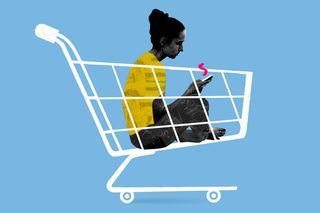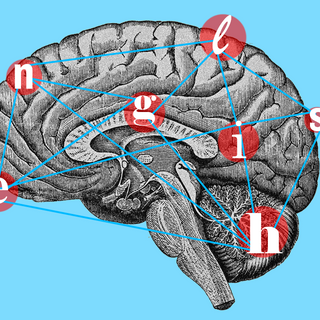
How Phone Addiction May Be Linked to Compulsive Shopping Behaviors
“[T]he association… might be mediated by smartphone-induced flow experiences and mood regulation activities using smartphones.”

A new study has established a link between smartphone addiction and compulsive shopping. Published in Computers in Human Behavior, the study investigated the impact of smartphones on consumer spending habits. Turns out, people exhibiting heightened levels of smartphone addiction — defined by the researchers as “excessive use of smartphones characterized by uncontrolled usage, neglect of daily activities, and negative consequences for user’s life” — were also more inclined to indulge in compulsive shopping online.
In the present day and age, smartphone addiction is an undeniable reality — perhaps, even inevitable. More than 6% of the 3.8 billion smartphone users on the planet are reportedly addicted to smartphones; in fact, there’s a name for the addiction, too: nomophobia, or the fear of one being separated from their smartphone.
Simultaneously, compulsive shopping — described as “a consumer’s tendency to be preoccupied with buying that is revealed through repetitive buying and a lack of impulse control” — is on the rise as well. Research from 2015 found that one in 20 people may struggle with a shopping addiction.
Both smartphone addiction and compulsive shopping can jeopardize people’s lives — both socially and financially. Yet, neither of them is recognized by the DSM-5 (the fifth edition of the Diagnostic and Statistical Manual). It is this lack of systematic research into the link between the two that led the study authors to dub their findings as a “novel connection.”
Related on The Swaddle:
For People With Poor Impulse Control, Instant Food Delivery Apps Can Kickstart Disordered Eating
The findings of the study were based on a survey of more than 250 participants belonging to Generation Z — or “Gen Z,” as it’s colloquially known. Often described as the “digital natives” — alongside millennials who have grown up with adequate access to technology to be able to keep up with digital advancements in their day-to-day lives comfortably — Gen Z, being born post-1996, has barely experienced life without technology. That’s precisely what drove the researchers to focus on Gen Z participants
In course of the study, the researchers made an interesting discovery: smartphone addiction did predict compulsive shopping, but not so much unless the users were relying on their phones to regulate their mood, and often lost their sense of time and space when hooked to their phone screens; the latter was described as a “flow state” induced by smartphone use. Together, they mediated the link between smartphone addiction and compulsive shopping, the researchers concluded.
Using smartphones to mitigate — if not entirely flip — the impact of negative moods can lead one to experience “greater exposure to online environments such as shopping platforms and social media and their funny and thrilling experiences. This may significantly contribute to the generation of ‘flow’ states, which may act as a trigger for their compulsive buying behavior,” notes the study.
In the past, too, the link between mood regulation through phones, and consequent compulsive shopping, has been explored anecdotally. “During exams, I easily get bored and start using my phone too much. Eventually, I started scrolling through the shopping apps I had. The first few days I didn’t see any harm [until] I started ordering unnecessary things I didn’t need,” Nayanita, 23, had told The Swaddle. “I felt something is going wrong — it took away a lot of my precious time, [and] my balances were also running out. There came a point when I was simultaneously shopping in-store, too — I knew I was getting uncontrollable, but I couldn’t help myself.”
Related on The Swaddle:
Drinking Coffee Before Shopping Is a Bad Idea – It Leads to Impulse Buying
The connection between smartphone addiction and shopping is rendered even more concerning in light of a phenomenon that already connects them in real life: targeted ads on social media. We have all been bombarded by ads, fuelled by intrusive algorithms, while scrolling through our social media feeds — be it Instagram, Facebook, or even Reddit. Research suggests that more than 90% of consumers are encouraged to buy things when brands personalize their communication with them through targeted ads. And when someone spends more time on the phone, their likelihood of encountering targeted ads increases, which might explain their propensity to compulsively shop.
“[People] evaluated themselves as more sophisticated after receiving an ad that they thought was individually targeted to them, compared to when they thought the same ad was not targeted [since they] saw the targeted ad as reflective of their own characteristics,” noted the Harvard Business Review, reporting on a 2016 study. “The ad told them that, based on their browsing history, they had sophisticated tastes. They accepted this information, saw themselves as more sophisticated consumers, and this shift in how they saw themselves increased their interest in the sophisticated product.”
Basically, targeted ads serve to manipulate users. In the process, they can be yet another mediating factor further strengthening the link between smartphone addiction and compulsive shopping. This, then, is yet another nuance to the connection that has escaped the ambit of the present research.
Nonetheless, findings like the one put forth by the present study, are much needed — they enhance our understanding of behaviors that often escape the attention of researchers.
Devrupa Rakshit is an Associate Editor at The Swaddle. She is a lawyer by education, a poet by accident, a painter by shaukh, and autistic by birth. You can find her on Instagram @devruparakshit.
Related


Myers‑Briggs Test Has Been Debunked Time and Again. Why Do Companies Still Use It?
